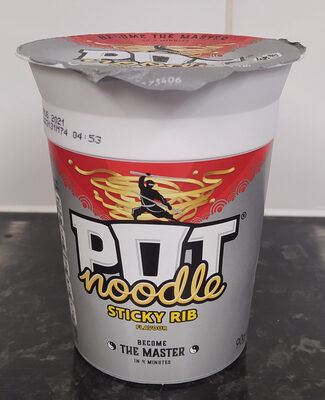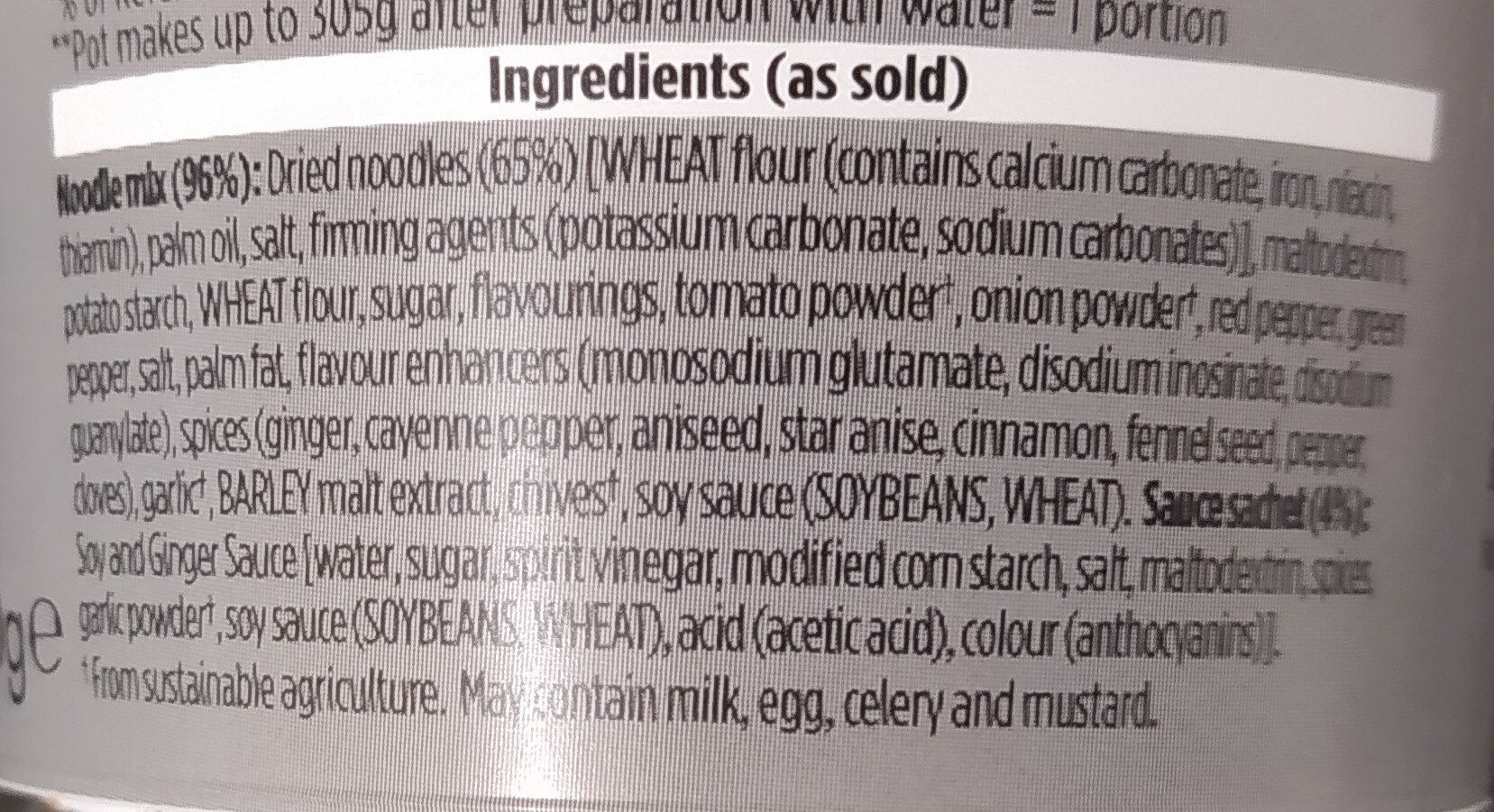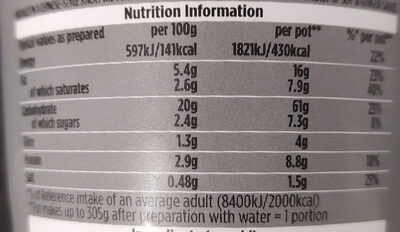Help us make food transparency the norm!
As a non-profit organization, we depend on your donations to continue informing consumers around the world about what they eat.
The food revolution starts with you!
Pot Noodle Sticky Rib - 90 g
Pot Noodle Sticky Rib - 90 g
This product page is not complete. You can help to complete it by editing it and adding more data from the photos we have, or by taking more photos using the app for Android or iPhone/iPad. Thank you!
×
Barcode: 8718114797977 (EAN / EAN-13)
Quantity: 90 g
Packaging: Aluminium-wrapper, Mixed plastic-packet, Pp-pot
Brands: Pot Noodle
Categories: Plant-based foods and beverages, Plant-based foods, Cereals and potatoes, Cereals and their products, Meals, Dried products, Pasta dishes, Pastas, Dried products to be rehydrated, Noodles, Instant noodles, Chinese noodles, Pot noodles
Labels, certifications, awards:
Vegetarian, European Vegetarian Union, European Vegetarian Union Vegetarian, Green Dot


Countries where sold: France, United Kingdom
Matching with your preferences
Health
Ingredients
-
57 ingredients
dried noodles 65% ( wheat flour (contains calcium carbonate, iron, niacin, thiamin), palm oil, salt, firming agents (potassium carbonate, sodium carbonates)), maltodextrin, potato starch, wheat flour, sugar, flavourings, tomato powder, onion powder, red pepper, green pepper, salt, palm fat, flavour enhancers (monosodium glutamate, disodium inosinate, disodium guanylate), spices (ginger, cayenne pepper, aniseed, star anise, cinnamon, fennel seed, pepper, cloves), garlic, barley malt extract, chives, soy sauce ( soybeans , wheat ), sauce 4% (water, sugar, spirit vinegar, modified corn starch, salt, maltodextrin, spices, garlic powder, soy sauce ( soybeans , wheat ), acid (acetic acid), colour (anthocyanins))Allergens: Gluten, SoybeansTraces: Celery, Eggs, Milk, Mustard
Food processing
-
Ultra processed foods
Elements that indicate the product is in the 4 - Ultra processed food and drink products group:
- Additive: E163 - Anthocyanins
- Additive: E621 - Monosodium glutamate
- Additive: E627 - Disodium guanylate
- Additive: E631 - Disodium inosinate
- Ingredient: Colour
- Ingredient: Firming agent
- Ingredient: Flavour enhancer
- Ingredient: Flavouring
- Ingredient: Maltodextrin
Food products are classified into 4 groups according to their degree of processing:
- Unprocessed or minimally processed foods
- Processed culinary ingredients
- Processed foods
- Ultra processed foods
The determination of the group is based on the category of the product and on the ingredients it contains.
Additives
-
E163 - Anthocyanins
Anthocyanin: Anthocyanins -also anthocyans; from Greek: ἄνθος -anthos- "flower" and κυάνεος/κυανοῦς kyaneos/kyanous "dark blue"- are water-soluble vacuolar pigments that, depending on their pH, may appear red, purple, or blue. Food plants rich in anthocyanins include the blueberry, raspberry, black rice, and black soybean, among many others that are red, blue, purple, or black. Some of the colors of autumn leaves are derived from anthocyanins.Anthocyanins belong to a parent class of molecules called flavonoids synthesized via the phenylpropanoid pathway. They occur in all tissues of higher plants, including leaves, stems, roots, flowers, and fruits. Anthocyanins are derived from anthocyanidins by adding sugars. They are odorless and moderately astringent. Although approved to color foods and beverages in the European Union, anthocyanins are not approved for use as a food additive because they have not been verified as safe when used as food or supplement ingredients. There is no conclusive evidence anthocyanins have any effect on human biology or diseases.Source: Wikipedia
-
E260 - Acetic acid
Acetic acid: Acetic acid , systematically named ethanoic acid , is a colorless liquid organic compound with the chemical formula CH3COOH -also written as CH3CO2H or C2H4O2-. When undiluted, it is sometimes called glacial acetic acid. Vinegar is no less than 4% acetic acid by volume, making acetic acid the main component of vinegar apart from water. Acetic acid has a distinctive sour taste and pungent smell. In addition to household vinegar, it is mainly produced as a precursor to polyvinyl acetate and cellulose acetate. It is classified as a weak acid since it only partially dissociates in solution, but concentrated acetic acid is corrosive and can attack the skin. Acetic acid is the second simplest carboxylic acid -after formic acid-. It consists of a methyl group attached to a carboxyl group. It is an important chemical reagent and industrial chemical, used primarily in the production of cellulose acetate for photographic film, polyvinyl acetate for wood glue, and synthetic fibres and fabrics. In households, diluted acetic acid is often used in descaling agents. In the food industry, acetic acid is controlled by the food additive code E260 as an acidity regulator and as a condiment. In biochemistry, the acetyl group, derived from acetic acid, is fundamental to all forms of life. When bound to coenzyme A, it is central to the metabolism of carbohydrates and fats. The global demand for acetic acid is about 6.5 million metric tons per year -Mt/a-, of which approximately 1.5 Mt/a is met by recycling; the remainder is manufactured from methanol. Vinegar is mostly dilute acetic acid, often produced by fermentation and subsequent oxidation of ethanol.Source: Wikipedia
-
E501 - Potassium carbonates
Potassium carbonate: Potassium carbonate -K2CO3- is a white salt, which is soluble in water -insoluble in ethanol- and forms a strongly alkaline solution. It can be made as the product of potassium hydroxide's absorbent reaction with carbon dioxide. It is deliquescent, often appearing a damp or wet solid. Potassium carbonate is used in the production of soap and glass.Source: Wikipedia
-
E501i - Potassium carbonate
Potassium carbonate: Potassium carbonate -K2CO3- is a white salt, which is soluble in water -insoluble in ethanol- and forms a strongly alkaline solution. It can be made as the product of potassium hydroxide's absorbent reaction with carbon dioxide. It is deliquescent, often appearing a damp or wet solid. Potassium carbonate is used in the production of soap and glass.Source: Wikipedia
-
E621 - Monosodium glutamate
Monosodium glutamate: Monosodium glutamate -MSG, also known as sodium glutamate- is the sodium salt of glutamic acid, one of the most abundant naturally occurring non-essential amino acids. Glutamic acid is found naturally in tomatoes, grapes, cheese, mushrooms and other foods.MSG is used in the food industry as a flavor enhancer with an umami taste that intensifies the meaty, savory flavor of food, as naturally occurring glutamate does in foods such as stews and meat soups. It was first prepared in 1908 by Japanese biochemist Kikunae Ikeda, who was trying to isolate and duplicate the savory taste of kombu, an edible seaweed used as a base for many Japanese soups. MSG as a flavor enhancer balances, blends, and rounds the perception of other tastes.The U.S. Food and Drug Administration has given MSG its generally recognized as safe -GRAS- designation. A popular belief is that large doses of MSG can cause headaches and other feelings of discomfort, known as "Chinese restaurant syndrome," but double-blind tests fail to find evidence of such a reaction. The European Union classifies it as a food additive permitted in certain foods and subject to quantitative limits. MSG has the HS code 29224220 and the E number E621.Source: Wikipedia
-
E627 - Disodium guanylate
Disodium guanylate: Disodium guanylate, also known as sodium 5'-guanylate and disodium 5'-guanylate, is a natural sodium salt of the flavor enhancing nucleotide guanosine monophosphate -GMP-. Disodium guanylate is a food additive with the E number E627. It is commonly used in conjunction with glutamic acid. As it is a fairly expensive additive, it is not used independently of glutamic acid; if disodium guanylate is present in a list of ingredients but MSG does not appear to be, it is likely that glutamic acid is provided as part of another ingredient such as a processed soy protein complex. It is often added to foods in conjunction with disodium inosinate; the combination is known as disodium 5'-ribonucleotides. Disodium guanylate is produced from dried seaweed and is often added to instant noodles, potato chips and other snacks, savory rice, tinned vegetables, cured meats, and packaged soup.Source: Wikipedia
-
E631 - Disodium inosinate
Disodium inosinate: Disodium inosinate -E631- is the disodium salt of inosinic acid with the chemical formula C10H11N4Na2O8P. It is used as a food additive and often found in instant noodles, potato chips, and a variety of other snacks. Although it can be obtained from bacterial fermentation of sugars, it is often commercially prepared from animal sources.Source: Wikipedia
Ingredients analysis
-
Palm oil
Ingredients that contain palm oil: Palm oil, Palm fat
-
Vegan status unknown
Unrecognized ingredients: Iron, Thiamin
-
Vegetarian
No non-vegetarian ingredients detected
Unrecognized ingredients: Iron, Thiamin
-
Details of the analysis of the ingredients
: noodles 65% (wheat flour (contains calcium carbonate, iron, niacin, thiamin), palm oil, salt, firming agents (potassium carbonate, sodium carbonates)), maltodextrin, potato starch, wheat flour, sugar, flavourings, tomato, onion, red pepper, green pepper, salt, palm fat, flavour enhancers (monosodium glutamate, disodium inosinate, disodium guanylate), spices (ginger, cayenne pepper, aniseed, star anise, cinnamon, fennel seed, pepper, cloves), garlic, barley malt extract, chives, soy sauce (soybeans, wheat), sauce 4% (water, sugar, spirit vinegar, modified corn starch, salt, maltodextrin, spices, garlic, soy sauce (soybeans, wheat), acid (acetic acid), colour (anthocyanins))- noodles -> en:noodle - vegan: maybe - vegetarian: maybe - percent: 65
- wheat flour -> en:wheat-flour - vegan: yes - vegetarian: yes - ciqual_proxy_food_code: 9410
- contains calcium carbonate -> en:e170i - vegan: maybe - vegetarian: maybe
- iron -> en:iron
- niacin -> en:e375 - vegan: maybe - vegetarian: maybe
- thiamin -> en:thiamin
- palm oil -> en:palm-oil - vegan: yes - vegetarian: yes - from_palm_oil: yes - ciqual_food_code: 16129
- salt -> en:salt - vegan: yes - vegetarian: yes - ciqual_food_code: 11058
- firming agents -> en:firming-agent
- potassium carbonate -> en:e501i - vegan: yes - vegetarian: yes
- sodium carbonates -> en:e500 - vegan: yes - vegetarian: yes
- wheat flour -> en:wheat-flour - vegan: yes - vegetarian: yes - ciqual_proxy_food_code: 9410
- maltodextrin -> en:maltodextrin - vegan: yes - vegetarian: yes
- potato starch -> en:potato-starch - vegan: yes - vegetarian: yes - ciqual_proxy_food_code: 9510
- wheat flour -> en:wheat-flour - vegan: yes - vegetarian: yes - ciqual_proxy_food_code: 9410
- sugar -> en:sugar - vegan: yes - vegetarian: yes - ciqual_proxy_food_code: 31016
- flavourings -> en:flavouring - vegan: maybe - vegetarian: maybe
- tomato -> en:tomato - vegan: yes - vegetarian: yes - ciqual_food_code: 20047
- onion -> en:onion - vegan: yes - vegetarian: yes - ciqual_food_code: 20034
- red pepper -> en:red-bell-pepper - vegan: yes - vegetarian: yes - ciqual_food_code: 20087
- green pepper -> en:green-pepper - vegan: yes - vegetarian: yes
- salt -> en:salt - vegan: yes - vegetarian: yes - ciqual_food_code: 11058
- palm fat -> en:palm-fat - vegan: yes - vegetarian: yes - from_palm_oil: yes - ciqual_proxy_food_code: 16129
- flavour enhancers -> en:flavour-enhancer
- monosodium glutamate -> en:e621 - vegan: yes - vegetarian: yes
- disodium inosinate -> en:e631 - vegan: maybe - vegetarian: maybe
- disodium guanylate -> en:e627 - vegan: maybe - vegetarian: maybe
- spices -> en:spice - vegan: yes - vegetarian: yes
- ginger -> en:ginger - vegan: yes - vegetarian: yes - ciqual_food_code: 11074
- cayenne pepper -> en:cayenne-pepper - vegan: yes - vegetarian: yes - ciqual_food_code: 11088
- aniseed -> en:aniseed - vegan: yes - vegetarian: yes
- star anise -> en:star-anise - vegan: yes - vegetarian: yes
- cinnamon -> en:cinnamon - vegan: yes - vegetarian: yes
- fennel seed -> en:fennel-seed - vegan: yes - vegetarian: yes - ciqual_food_code: 11066
- pepper -> en:pepper - vegan: yes - vegetarian: yes
- cloves -> en:clove - vegan: yes - vegetarian: yes - ciqual_food_code: 11052
- garlic -> en:garlic - vegan: yes - vegetarian: yes - ciqual_food_code: 11000
- barley malt extract -> en:barley-malt-extract - vegan: yes - vegetarian: yes
- chives -> en:chives - vegan: yes - vegetarian: yes - ciqual_food_code: 11003
- soy sauce -> en:soy-sauce - vegan: maybe - vegetarian: maybe - ciqual_food_code: 11104
- soybeans -> en:soya-bean - vegan: yes - vegetarian: yes - ciqual_food_code: 20901
- wheat -> en:wheat - vegan: yes - vegetarian: yes - ciqual_proxy_food_code: 9410
- sauce -> en:sauce - vegan: maybe - vegetarian: maybe - percent: 4
- water -> en:water - vegan: yes - vegetarian: yes - ciqual_food_code: 18066
- sugar -> en:sugar - vegan: yes - vegetarian: yes - ciqual_proxy_food_code: 31016
- spirit vinegar -> en:spirit-vinegar - vegan: yes - vegetarian: yes - ciqual_food_code: 11018
- modified corn starch -> en:modified-corn-starch - vegan: yes - vegetarian: yes - ciqual_food_code: 9510
- salt -> en:salt - vegan: yes - vegetarian: yes - ciqual_food_code: 11058
- maltodextrin -> en:maltodextrin - vegan: yes - vegetarian: yes
- spices -> en:spice - vegan: yes - vegetarian: yes
- garlic -> en:garlic - vegan: yes - vegetarian: yes - ciqual_food_code: 11000
- soy sauce -> en:soy-sauce - vegan: maybe - vegetarian: maybe - ciqual_food_code: 11104
- soybeans -> en:soya-bean - vegan: yes - vegetarian: yes - ciqual_food_code: 20901
- wheat -> en:wheat - vegan: yes - vegetarian: yes - ciqual_proxy_food_code: 9410
- acid -> en:acid
- acetic acid -> en:e260 - vegan: yes - vegetarian: yes
- colour -> en:colour
- anthocyanins -> en:e163 - vegan: yes - vegetarian: yes
- noodles -> en:noodle - vegan: maybe - vegetarian: maybe - percent: 65
-
Nutrition facts
Nutrition facts As sold
for 100 g / 100 mlCompared to: Pot noodles Energy 590 kj
(141 kcal)+12% Fat 5.4 g +30% Saturated fat 2.6 g +34% Carbohydrates 20 g +12% Sugars 2.4 g +37% Fiber 1.3 g +11% Proteins 2.9 g -4% Salt 0.48 g -19% Fruits‚ vegetables‚ nuts and rapeseed‚ walnut and olive oils (estimate from ingredients list analysis) 0.14 %
Environment
-
Eco-Score C - Moderate environmental impact
The Eco-Score is an experimental score that summarizes the environmental impacts of food products.→ The Eco-Score was initially developped for France and it is being extended to other European countries. The Eco-Score formula is subject to change as it is regularly improved to make it more precise and better suited to each country.Life cycle analysis
-
Average impact of products of the same category: A (Score: 82/100)
Category: Asian noodles, flavoured, dehydrated
Category: Asian noodles, flavoured, dehydrated
- PEF environmental score: 0.26 (the lower the score, the lower the impact)
- including impact on climate change: 1.67 kg CO2 eq/kg of product
Stage Impact Agriculture
65.5 %Processing
20.6 %Packaging
8.7 %Transportation
3.5 %Distribution
1.8 %Consumption
0.0 %
Bonuses and maluses
-
Missing origins of ingredients information
Malus: -5
⚠ ️ The origins of the ingredients of this product are not indicated.
If they are indicated on the packaging, you can modify the product sheet and add them.
If you are the manufacturer of this product, you can send us the information with our free platform for producers.
-
Ingredients that threatens species
Malus: -10
Contains palm oil
Tropical forests in Asia, Africa and Latin America are destroyed to create and expand oil palm tree plantations. The deforestation contributes to climate change, and it endangers species such as the orangutan, the pigmy elephant and the Sumatran rhino.
-
Packaging with a high impact
Malus: -15
Shape Material Recycling Impact Packet Plastic High Wrapper Heavy aluminium Medium Pot PP 5 - Polypropylene High Packet Plastic High ⚠ ️ The information about the packaging of this product is not sufficiently precise (exact shapes and materials of all components of the packaging).⚠ ️ For a more precise calculation of the Eco-Score, you can modify the product page and add them.
If you are the manufacturer of this product, you can send us the information with our free platform for producers.
Eco-Score for this product
-
Impact for this product: C (Score: 52/100)
Product: Pot Noodle Sticky Rib - 90 g
Life cycle analysis score: 82
Sum of bonuses and maluses: -30
Final score: 52/100
-
Carbon footprint
-
Equal to driving 0.9 km in a petrol car
167 g CO² per 100g of product
The carbon emission figure comes from ADEME's Agribalyse database, for the category: Asian noodles, flavoured, dehydrated (Source: ADEME Agribalyse Database)
Stage Impact Agriculture
61.0 %Processing
14.9 %Packaging
16.3 %Transportation
6.8 %Distribution
1.0 %Consumption
0.0 %
Packaging
-
Packaging with a high impact
-
Packaging parts
Packet (Plastic)
Wrapper (Aluminium)
Pot (PP 5 - Polypropylene)
Packet (Plastic)
-
Packaging materials
Material % Packaging weight Packaging weight per 100 g of product Plastic Metal Total
-
Transportation
-
Origins of ingredients
Missing origins of ingredients information
⚠ ️ The origins of the ingredients of this product are not indicated.
If they are indicated on the packaging, you can modify the product sheet and add them.
If you are the manufacturer of this product, you can send us the information with our free platform for producers.Add the origins of ingredients for this product Add the origins of ingredients for this product
Threatened species
-
Contains palm oil
Drives deforestation and threatens species such as the orangutan
Tropical forests in Asia, Africa and Latin America are destroyed to create and expand oil palm tree plantations. The deforestation contributes to climate change, and it endangers species such as the orangutan, the pigmy elephant and the Sumatran rhino.
Report a problem
-
Incomplete or incorrect information?
Category, labels, ingredients, allergens, nutritional information, photos etc.
If the information does not match the information on the packaging, please complete or correct it. Open Food Facts is a collaborative database, and every contribution is useful for all.
Data sources
Product added on by kiliweb
Last edit of product page on by inf.
Product page also edited by aleene, date-limite-app, doublah, openfoodfacts-contributors, roboto-app, spotter, swipe-studio, yuka.Wm9jTlFmNFFnK0ZidDgwUDlUS0sydHNxNExXdVlGNldPZEVUSVE9PQ.








